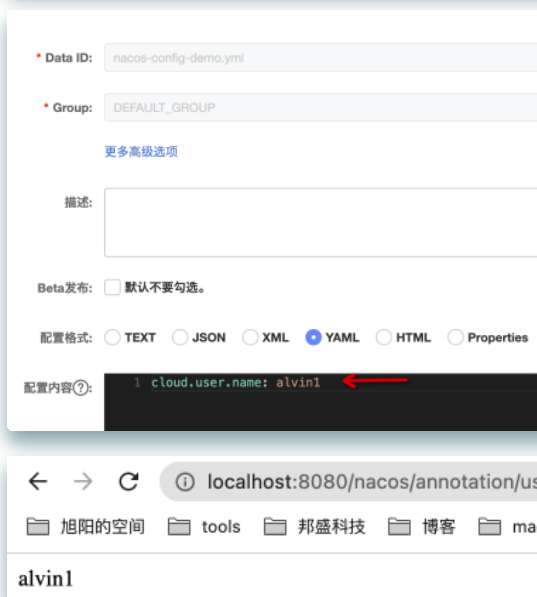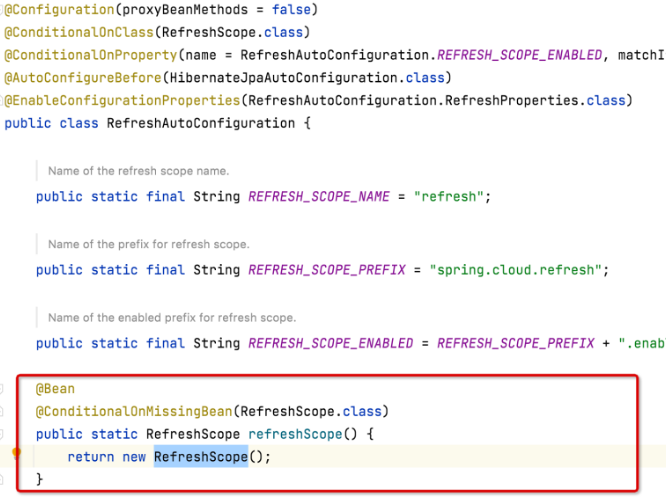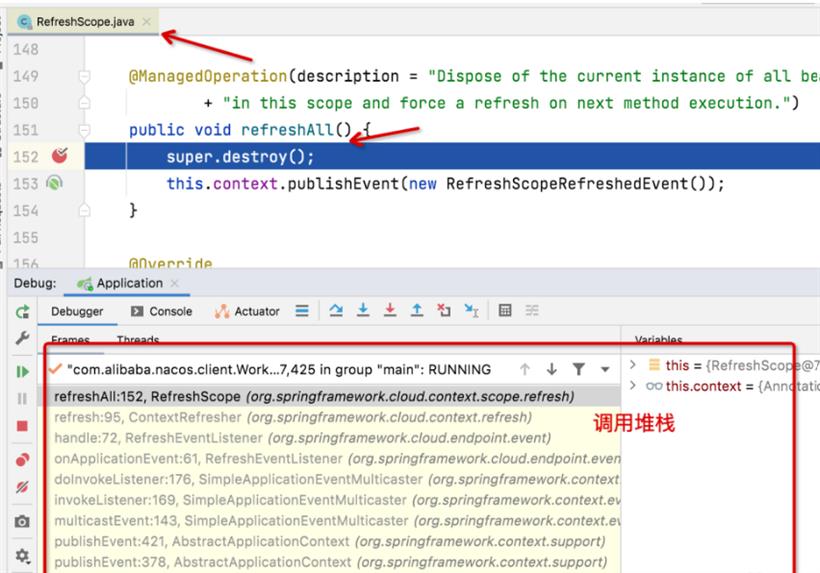- 联系我们
- duidaima.com 版权声明
- 闽ICP备2020021581号
-
 闽公网安备 35020302035485号
闽公网安备 35020302035485号
 闽公网安备 35020302035485号
闽公网安备 35020302035485号
/**
* Convenience annotation to put a <code>@Bean</code> definition in
* {@link org.springframework.cloud.context.scope.refresh.RefreshScope refresh scope}.
* Beans annotated this way can be refreshed at runtime and any components that are using
* them will get a new instance on the next method call, fully initialized and injected
* with all dependencies.
*
* @堆代码 duidaima.com
*
*/
@Target({ ElementType.TYPE, ElementType.METHOD })
@Retention(RetentionPolicy.RUNTIME)
@Scope("refresh")
@Documented
public @interface RefreshScope {
/**
* @see Scope#proxyMode()
* @return proxy mode
*/
ScopedProxyMode proxyMode() default ScopedProxyMode.TARGET_CLASS;
}
.上面是RefreshScope的源码,该注解被@Scope注解使用,@Scope用来比较Spring Bean的作用域,具体使用参考相关文章。




public abstract class AbstractBeanFactory extends FactoryBeanRegistrySupport implements ConfigurableBeanFactory {
protected < T > T doGetBean(
String name, @Nullable Class < T > requiredType, @Nullable Object[] args, boolean typeCheckOnly)
throws BeansException {
// 堆代码 duidaima.com
// 如果scope是单例的情况, 这里不进行分析
if (mbd.isSingleton()) {
.....
}
// 如果scope是prototype的情况, 这里不进行分析
else if (mbd.isPrototype()) {
......
}
// 如果scope是其他的情况,本例中是reresh
else {
String scopeName = mbd.getScope();
if (!StringUtils.hasLength(scopeName)) {
throw new IllegalStateException("No scope name defined for bean '" + beanName + "'");
}
// 获取refresh scope的实现类RefreshScope,这个类在哪里注入,我们后面讲
Scope scope = this.scopes.get(scopeName);
if (scope == null) {
throw new IllegalStateException("No Scope registered for scope name '" + scopeName + "'");
}
try {
// 这边是获取bean,调用的是RefreshScope中的的方法
Object scopedInstance = scope.get(beanName, () - > {
beforePrototypeCreation(beanName);
try {
return createBean(beanName, mbd, args);
} finally {
afterPrototypeCreation(beanName);
}
});
beanInstance = getObjectForBeanInstance(scopedInstance, name, beanName, mbd);
} catch (IllegalStateException ex) {
throw new ScopeNotActiveException(beanName, scopeName, ex);
}
}
} catch (BeansException ex) {
beanCreation.tag("exception", ex.getClass().toString());
beanCreation.tag("message", String.valueOf(ex.getMessage()));
cleanupAfterBeanCreationFailure(beanName);
throw ex;
} finally {
beanCreation.end();
}
}
return adaptBeanInstance(name, beanInstance, requiredType);
}
}
2.RefreshScope继承成了GenericScope类,最终调用的的是GenericScope的get方法public class GenericScope
implements Scope, BeanFactoryPostProcessor, BeanDefinitionRegistryPostProcessor, DisposableBean {@
Override
public Object get(String name, ObjectFactory <? > objectFactory) {
// 将bean添加到缓存cache中
BeanLifecycleWrapper value = this.cache.put(name, new BeanLifecycleWrapper(name, objectFactory));
this.locks.putIfAbsent(name, new ReentrantReadWriteLock());
try {
// 调用下面的getBean方法
return value.getBean();
} catch (RuntimeException e) {
this.errors.put(name, e);
throw e;
}
}
private static class BeanLifecycleWrapper {
public Object getBean() {
// 如果bean为空,则创建bean
if (this.bean == null) {
synchronized(this.name) {
if (this.bean == null) {
this.bean = this.objectFactory.getObject();
}
}
}
// 否则返回之前创建好的bean
return this.bean;
}
}
}
小结:

public class RefreshEventListener implements SmartApplicationListener {
........
public void handle(RefreshEvent event) {
if (this.ready.get()) { // don't handle events before app is ready
log.debug("Event received " + event.getEventDesc());
// 会调用refresh方法,进行刷新
Set < String > keys = this.refresh.refresh();
log.info("Refresh keys changed: " + keys);
}
}
}
// 这个是ContextRefresher类中的刷新方法
public synchronized Set < String > refresh() {
// 刷新spring的envirionment 变量配置
Set < String > keys = refreshEnvironment();
// 刷新其他scope
this.scope.refreshAll();
return keys;
}
refresh方法最终调用destroy方法, 清空之前缓存的bean
public class RefreshScope extends GenericScope
implements ApplicationContextAware, ApplicationListener < ContextRefreshedEvent > , Ordered {
@
ManagedOperation(description = "Dispose of the current instance of all beans " + "in this scope and force a refresh on next method execution.")
public void refreshAll() {
// 调用父类的destroy
super.destroy();
this.context.publishEvent(new RefreshScopeRefreshedEvent());
}
}
@
Override
public void destroy() {
List < Throwable > errors = new ArrayList < Throwable > ();
Collection < BeanLifecycleWrapper > wrappers = this.cache.clear();
for (BeanLifecycleWrapper wrapper: wrappers) {
try {
Lock lock = this.locks.get(wrapper.getName()).writeLock();
lock.lock();
try {
// 这里主要就是把之前的bean设置为null, 就会重新走createBean的流程了
wrapper.destroy();
} finally {
lock.unlock();
}
} catch (RuntimeException e) {
errors.add(e);
}
}
if (!errors.isEmpty()) {
throw wrapIfNecessary(errors.get(0));
}
this.errors.clear();
}
总结